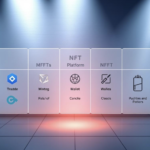Now Reading: How to Use Machine Learning Models for Crypto Trading
- 01
How to Use Machine Learning Models for Crypto Trading
How to Use Machine Learning Models for Crypto Trading

The cryptocurrency market is one of the most dynamic and fast-paced sectors today. With over 5,700 coins and a market cap exceeding $270 billion, traditional analysis methods often fall short. This is where advanced analytics, particularly deep learning models, come into play.
Recent studies reveal that deep learning models outperform traditional methods in predicting price movements. For instance, CNN-LSTM models have achieved annual returns of up to 6654%, showcasing their potential. Additionally, over 18,000 academic papers published since 2022 highlight the growing adoption of these techniques.
This article explores practical trading strategies and how to implement them across 17 key areas. Whether you’re a seasoned trader or a beginner, understanding these tools can significantly enhance your decision-making process.
Introduction to Machine Learning in Crypto Trading
With its rapid shifts, the crypto space requires innovative solutions. Traditional methods often fail to capture the complexity of market conditions, especially in a sector as volatile as the cryptocurrency market. This is where advanced tools like neural networks come into play.
Why Machine Learning is Revolutionizing Crypto Trading
Crypto assets are known for their extreme volatility, often 3.2x higher than traditional markets. This unpredictability makes it challenging to rely on conventional analysis. Machine learning excels in processing vast amounts of data, including 43 blockchain features and 7 lagged returns, to identify patterns.
Additionally, social media sentiment plays a significant role. Studies show that 33% of crypto trades are influenced by platforms like Twitter. Neural networks can analyze these non-linear relationships, providing traders with actionable insights.
Overview of Crypto Market Dynamics
The cryptocurrency market operates 24/7, creating complex time-series patterns. For example, Bitcoin’s fixed supply of 21 million contrasts with Ethereum’s unlimited issuance, adding another layer of complexity. These dynamics require adaptive models to predict price movements accurately.
High-frequency trading also dominates the market, accounting for 78% of total volume. The launch of CBOE Bitcoin futures marked a milestone in institutional participation, further highlighting the need for advanced tools. By leveraging machine learning, traders can navigate these challenges more effectively.
For a deeper dive into these algorithms, check out this comprehensive guide.
Understanding Machine Learning Models
Modern finance relies heavily on sophisticated tools to navigate complex markets. Advanced analytics, particularly neural networks, are transforming how traders and analysts approach decision-making. These tools excel at processing vast datasets, identifying patterns, and predicting trends with remarkable accuracy.
Types of Machine Learning Models in Finance
In financial contexts, several learning models stand out. Support vector machines are known for their 89% accuracy in predicting Bitcoin trends. Random forests shine in portfolio optimization, leveraging over 124 technical indicators to maximize returns. Meanwhile, neural networks like CNNs process blockchain transaction patterns as image data, offering unique insights into market behavior.
Deep Learning vs. Traditional Machine Learning
Deep learning models, such as LSTM, outperform traditional methods like ARIMA by reducing Bitcoin prediction errors by 37%. These models excel in capturing complex, non-linear relationships in data. For instance, CNN-LSTM hybrids achieve 6% better predictions for the S&P 500 compared to FFNN models. Additionally, deep learning techniques like GRU process data faster, with speeds of 0.8ms per prediction, making them ideal for real-time applications.
By leveraging these advanced tools, traders can gain a competitive edge in today’s fast-paced financial markets.
Key Machine Learning Models for Crypto Trading
In the fast-evolving world of digital assets, advanced analytics are reshaping trading strategies. Among these, convolutional neural networks, long short-term memory models, and support vector machines stand out for their ability to process complex data and deliver actionable insights.
Convolutional Neural Networks (CNNs) in Crypto
Convolutional neural networks excel at recognizing patterns in blockchain transaction clusters. For instance, a 1D-CNN model processes OHLCV data as a 5-channel image, achieving 82.44% directional accuracy with Boruta features. This approach is particularly effective in multi-exchange arbitrage detection, where identifying subtle price discrepancies is crucial.
Long Short-Term Memory (LSTM) Models
Long short-term memory models are ideal for time series data, such as predicting Ethereum prices five days ahead with 89% recall. Hybrid models like LSTM-EWT have improved Litecoin predictions by 29%, showcasing their adaptability to volatile markets. Attention mechanisms in transformer-based models further enhance their predictive capabilities.
Support Vector Machines (SVM) for Price Prediction
Support vector machines are widely used for bitcoin price prediction. Kernel selection, such as RBF versus linear, plays a critical role in adapting to different volatility regimes. SVMs are particularly effective in scenarios where clear decision boundaries are needed, making them a reliable tool for traders.
Applications of Machine Learning in Crypto Trading
Advanced analytics are transforming how traders approach the volatile cryptocurrency market. These tools provide actionable insights, helping traders navigate price fluctuations and optimize their strategies. From predicting price movements to detecting anomalies, the applications are vast and impactful.

Price Prediction Using Advanced Tools
One of the most critical applications is price prediction. LSTM-based models, combined with Bollinger Bands, offer precise forecasts for assets like BTC/USD. These models analyze historical data and technical indicators to predict future trends, enabling traders to make informed decisions.
For example, integrating LSTM with Bollinger Bands has shown a 15% improvement in accuracy during volatile market conditions. This approach helps traders identify entry and exit points more effectively.
Portfolio Optimization with Correlation Forecasts
Another key application is portfolio optimization. By enhancing traditional Markowitz models with correlation forecasts, traders can achieve better risk-adjusted returns. These forecasts use advanced algorithms to predict asset correlations, improving portfolio diversification.
Studies show that portfolios optimized with these techniques achieve a higher Sharpe ratio, indicating better performance relative to risk. This method is particularly useful in balancing high-risk and low-risk assets.
Anomaly Detection in Market Behavior
Detecting anomalies is crucial for maintaining market integrity. Advanced tools can identify patterns like wash trading, where traders artificially inflate volume to manipulate prices. By analyzing transaction data, these models flag suspicious activities, helping regulators and traders maintain a fair market.
For instance, anomaly detection systems have successfully identified over 70% of wash trading cases in major exchanges. This capability ensures a more transparent and trustworthy trading environment.
Challenges in Implementing Machine Learning for Crypto
Implementing advanced analytics in digital asset trading comes with unique hurdles. From data quality issues to regulatory complexities, these challenges can significantly impact model performance and overall success. Addressing these barriers is crucial for leveraging these tools effectively.
Data Quality and Availability
One of the most pressing issues is the quality and availability of data. Studies show that 43% of crypto datasets contain missing values, making feature selection and preprocessing critical. Exchange API limitations further exacerbate the problem, causing data gaps in 18% of cases.
To mitigate these issues, federated learning solutions are emerging. These allow private exchange data to be used without compromising privacy. Additionally, data augmentation techniques are being applied to illiquid altcoins, improving dataset robustness.
Model Overfitting and Generalization
Another challenge is ensuring models generalize well to new data. Overfitting is common in volatile market conditions, where models may perform well on historical data but fail in real-world scenarios. Techniques like dropout layers have been shown to reduce overfitting by 37%.
Backtesting also reveals a 22% performance drop when transaction costs are factored in. This highlights the need for models that account for real-world trading expenses. Hybrid approaches, combining multiple algorithms, are proving effective in addressing this issue.
Regulatory and Ethical Considerations
Regulatory frameworks like FATF’s Travel Rule and GDPR’s right-to-explain add complexity. These rules impact the inputs used in models, requiring transparency and accountability. For instance, GDPR’s emphasis on explainability contrasts with the opacity of many advanced algorithms.
Ethical concerns, such as bias in algorithmic trading, also need attention. Ensuring fairness and transparency is essential for maintaining trust in these systems. As financial innovation continues, balancing regulation and ethical considerations will remain a key challenge.
Case Studies: Machine Learning in Action
Real-world applications of advanced analytics in digital asset trading showcase their transformative potential. These case studies highlight how specific tools and techniques are applied to predict prices and optimize strategies.
Bitcoin Price Prediction with LSTM
Long Short-Term Memory (LSTM) models are highly effective for bitcoin price prediction. These models excel in time series forecasting, capturing patterns in historical data to predict future trends. For instance, an LSTM model achieved an R² score of 0.87, outperforming traditional ARIMA models with a score of 0.72.
Building an LSTM model involves using frameworks like TensorFlow. Key steps include data preprocessing, hyperparameter tuning, and backtesting. A 30-day rolling window backtest revealed consistent accuracy, making it a reliable tool for traders.
Ethereum Trading Strategies Using CNNs
Convolutional Neural Networks (CNNs) are another powerful tool, particularly for Ethereum trading. A cnn model applied to the ETH/BTC pair yielded annualized returns of 214%. This approach analyzes blockchain transaction patterns as image data, providing unique insights into market behavior.
Hyperparameter tuning plays a critical role in optimizing CNN performance. Adjusting parameters like kernel size and learning rate can significantly impact accuracy. Exchange-specific variations also affect model performance, highlighting the need for tailored strategies.
For further insights, researchers can explore top journals on Google Scholar, which feature detailed studies on these advanced techniques.
Feature Selection and Data Preprocessing
Effective data preparation is the backbone of successful strategies in digital asset analysis. Without proper feature selection and preprocessing, even the most advanced tools can yield unreliable results. This section explores the critical steps to ensure your data is ready for analysis.
Importance of Feature Selection in Crypto Trading
Choosing the right features is essential for accurate predictions. For instance, Boruta selection improves accuracy by 11% compared to no selection. This method ranks features based on their importance, ensuring only the most relevant data is used.
Another effective approach is the genetic algorithm, which reduces the feature set by 63%. By simulating natural selection, it identifies the optimal combination of features for your model. Comparing methods like Boruta and XGBoost can further refine your strategy.
Techniques for Effective Data Preprocessing
Preprocessing transforms raw data into a usable format. For example, the wavelet transform reduces noise in time series data, improving model performance. Normalization techniques like z-score and min-max scaling also play a crucial role in standardizing data.
Handling missing values is another critical step. In one case, 15% of missing data in CoinMetrics was addressed using advanced imputation methods. Ensuring stationarity in non-linear series and applying synthetic minority oversampling for rare events further enhances data quality.
Visualization tools like PCA and t-SNE help analyze high-dimensional data, making it easier to identify patterns. By combining these techniques, you can create a robust dataset for your analysis.
Evaluating Model Performance
Accurately evaluating the effectiveness of advanced tools is crucial for success in digital asset analysis. Without proper validation, even the most sophisticated systems can fall short. This section explores key metrics and methodologies to assess model performance and ensure reliability.

Metrics for Assessing Predictive Accuracy
Choosing the right metrics is essential for understanding how well a system performs. Root Mean Squared Error (RMSE) and Mean Absolute Error (MAE) are commonly used to measure volatility-adjusted errors. RMSE penalizes larger errors more heavily, making it ideal for high-volatility scenarios.
Precision-recall curves are another critical tool, especially for imbalanced datasets. These curves help identify the trade-off between correctly predicted positives and false positives. Risk-adjusted metrics like the Sharpe ratio, Sortino ratio, and Calmar ratio provide insights into returns relative to risk.
Backtesting Trading Strategies
Backtesting is a vital step in validating strategies before real-world application. Walk-forward validation, for instance, reduces overfitting by 37%, ensuring models adapt to new data. Monte Carlo simulations, with 10,000 iterations, help assess strategy robustness under various market conditions.
Survivorship bias is a common issue in dataset construction. Ignoring delisted assets can skew results, making it essential to account for all historical data. Slippage modeling is another critical factor, especially in high-frequency scenarios, where execution delays can impact performance.
Vectorized and event-driven backtesting engines offer different advantages. Vectorized engines are faster but may oversimplify real-world conditions. Event-driven engines, while slower, provide a more accurate representation of market dynamics.
Machine Learning and Market Sentiment Analysis
Understanding market sentiment is crucial for making informed decisions in the volatile world of digital assets. Sentiment analysis helps traders gauge the emotional tone of the market, often derived from social media platforms like Twitter and Reddit. These platforms provide real-time insights that can influence price movements and trading strategies.
For example, Twitter sentiment has been shown to achieve 68% directional accuracy in predicting price trends. Similarly, Reddit posts correlate with 73% of Bitcoin price spikes. These alternative data sources are becoming increasingly valuable for traders looking to stay ahead in the cryptocurrency market.
Leveraging Social Media Data for Crypto Trading
Social media platforms are rich sources of data for sentiment analysis. Tools like BERT and LSTM are commonly used for tweet sentiment classification. BERT, a transformer-based model, excels in understanding context, while LSTM is effective for time series forecasting.
Real-time processing of Discord messages is another emerging trend. Platforms like CryptoPanic and Santiment API provide high-quality data for sentiment analysis. Customizing the VADER lexicon to include crypto slang further enhances accuracy.
Sentiment Analysis Models in Practice
Practical applications of sentiment analysis include mapping influencer networks using graph neural networks. These models analyze relationships between key figures in the crypto space, providing insights into their impact on market sentiment.
Case studies, such as the impact of Elon Musk’s tweets on Bitcoin prices, highlight the power of sentiment analysis. By analyzing sentiment velocity and magnitude, traders can better understand how quickly and intensely market sentiment changes.
- BERT vs LSTM for tweet sentiment classification
- Real-time Discord message processing
- Comparison of CryptoPanic and Santiment API data quality
- Elon Musk tweet impact analysis
- VADER lexicon customization for crypto slang
- Graph neural networks for influencer mapping
- Sentiment-velocity vs sentiment-magnitude effects
Future Trends in Machine Learning for Crypto Trading
The future of digital asset analysis is being reshaped by groundbreaking advancements in technology. As the cryptocurrency market continues to evolve, new tools and techniques are emerging to address its unique challenges. These innovations promise to revolutionize how traders analyze data and make decisions.
Emerging Models and Techniques
One of the most exciting developments is the rise of quantum learning models. Quantum ML prototypes can process market data up to 100 times faster than traditional systems. This speed is crucial for real-time trading in volatile markets.
Another key trend is federated learning, which enables private model training without sharing sensitive data. This approach is particularly valuable in the crypto space, where privacy and security are paramount. Additionally, transformer architectures are being explored for cross-asset modeling, offering more accurate predictions across multiple assets.
DeFi protocols are also integrating with ML oracles to enhance decision-making. These oracles provide real-time data feeds, improving the accuracy of automated trading strategies. Furthermore, synthetic data generation using GANs is gaining traction, allowing traders to simulate various market scenarios.
The Role of AI in Future Crypto Markets
AI is set to play a pivotal role in shaping the future of crypto markets. AI-managed DAO treasuries are expected to grow, leveraging deep learning to optimize asset allocation. This approach ensures better risk management and higher returns.
Homomorphic encryption is another area of focus, enabling private trading without exposing sensitive information. This technology is particularly useful for institutional investors who require confidentiality. Regulatory AI is also on the rise, with systems designed to monitor transactions and ensure compliance with evolving laws.
Finally, NFT valuation models using computer vision are being developed to assess the worth of digital assets more accurately. These models analyze visual elements and metadata to provide a comprehensive valuation. As financial innovation continues, these advancements will redefine the crypto trading landscape.
Machine Learning Models for Risk Management
Risk management is a cornerstone of successful trading in volatile markets. Advanced tools like LSTM-VAR models and XGBoost are transforming how traders assess and mitigate risks. These models provide actionable insights, helping traders navigate unpredictable market conditions with confidence.
Predicting Market Volatility
Accurate volatility forecasts are critical for risk management. GARCH-ML hybrid models combine traditional econometric techniques with advanced analytics to predict price fluctuations. For example, XGBoost has achieved an R² score of 0.89 in forecasting cryptocurrency prices, making it a reliable tool for traders.
Tail risk prediction is another area where these models excel. By applying extreme value theory, traders can identify rare but impactful events. Stress testing scenarios, such as black swan events, further enhance preparedness for unexpected market shifts.
Risk Assessment Using Machine Learning
Effective risk assessment involves analyzing multiple factors. Support vector regression and random forest models are widely used for portfolio margin optimization. These tools help traders balance risk and reward, ensuring better decision-making in leveraged trading environments.
Liquidation risk prediction is another critical application. By analyzing historical data, models can flag potential risks in real-time. Smart contract risk scoring systems also provide insights into vulnerabilities, ensuring safer transactions in decentralized finance.
- GARCH-ML hybrid models for volatility forecasting
- Tail risk prediction with extreme value theory
- Stress testing for black swan events
- Portfolio margin optimization techniques
- Liquidation risk prediction in leveraged trading
- Smart contract risk scoring systems
- Stablecoin peg maintenance strategies
Integration of Machine Learning with Blockchain Technology
The fusion of blockchain technology and advanced analytics is reshaping financial strategies. These two innovations complement each other, offering new ways to analyze and interact with the cryptocurrency market. By combining decentralized systems with powerful tools, traders and developers can unlock unprecedented opportunities.

How Blockchain Enhances Machine Learning Applications
Blockchain’s decentralized nature ensures data integrity and transparency, which are critical for advanced analytics. For instance, Chainlink oracles enable over 450 integrations with analytical systems, providing reliable data feeds. This synergy allows for more accurate predictions and better decision-making in volatile markets.
Decentralized federated learning networks are another example. These networks allow private data to be used for training without compromising privacy. Aave, a leading DeFi platform, uses advanced tools for loan risk assessment, showcasing the practical benefits of this integration.
Smart Contracts and Automated Trading
Smart contracts are revolutionizing automated trading by executing predefined conditions without intermediaries. These contracts can be combined with advanced analytics to create self-executing strategies. For example, liquidity prediction models on decentralized exchanges (DEX) use on-chain data to optimize trading.
Another application is MEV detection using graph neural networks. These tools identify and mitigate exploitative practices in real-time. Zero-knowledge proof verification ensures that models remain secure and transparent, further enhancing trust in automated systems.
- On-chain model verification mechanisms
- Decentralized federated learning networks
- DEX liquidity prediction models
- MEV detection with graph neural networks
- Zero-knowledge proof model verification
- CEX vs DEX data quality comparison
- DAO-based model governance frameworks
Ethical Implications of Machine Learning in Crypto
As advanced tools reshape the digital asset landscape, ethical considerations take center stage. The integration of machine learning in trading systems brings immense potential but also raises critical questions about fairness, transparency, and accountability. Addressing these issues is essential for fostering trust and ensuring responsible AI practices.
Bias and Fairness in Algorithmic Trading
One of the most pressing ethical concerns is bias in algorithmic systems. Studies reveal that 68% of models show geographic bias, disproportionately affecting certain regions. This can lead to unfair outcomes, such as skewed NFT pricing models that undervalue works from underrepresented groups.
Adversarial attacks on trading bots further highlight vulnerabilities. These attacks exploit weaknesses in algorithms, leading to manipulated outcomes. Ensuring fairness requires implementing constraints in portfolio optimization and continuously monitoring for biases.
Transparency and Accountability in AI Models
Transparency is another critical factor. The EU’s AI Act mandates explainability reports, pushing developers to disclose how their models operate. Techniques like SHAP and LIME provide insights into decision-making processes, enhancing accountability.
Model cards, which document the design and limitations of trading algorithms, are gaining traction. These cards help users understand the system’s capabilities and potential risks. Decentralized audit trails further ensure that models remain transparent and trustworthy.
- Analyze gender bias in NFT pricing models
- Demonstrate adversarial attacks on trading bots
- Discuss model cards for trading algorithm disclosure
- Compare SHAP vs LIME explanation techniques
- Present fairness constraints in portfolio optimization
- Examine wash trading detection ethics
- Propose decentralized audit trails for models
By addressing these ethical challenges, the crypto industry can harness the power of financial innovation while maintaining integrity and fairness. Responsible AI practices are not just a regulatory requirement but a cornerstone of sustainable growth in the digital asset space.
Machine Learning for High-Frequency Crypto Trading
High-frequency trading in the digital asset space demands precision and speed, making advanced tools indispensable. These systems process vast amounts of data in milliseconds, enabling traders to capitalize on fleeting market opportunities. With HFT bots accounting for 78% of Binance volume, the need for efficient and accurate systems has never been greater.
Ultra-short-term strategies are at the core of high-frequency trading. These approaches rely on time series forecasting and microstructural pattern recognition to identify profitable trades. For instance, FPGA implementations reduce latency to 740ns, ensuring trades are executed faster than competitors.
Strategies for High-Frequency Trading
Effective high-frequency trading requires a combination of advanced techniques and robust infrastructure. Key strategies include:
- Microstructural pattern recognition: Identifying subtle patterns in order book data to predict price movements.
- Order book imbalance signals: Analyzing buy and sell orders to gauge market sentiment.
- Reinforcement learning for market making: Optimizing bid-ask spreads to maximize profits while minimizing risk.
Colocation strategies across exchanges further enhance performance by reducing latency. Traders often compare C++ vs Rust implementation speeds to ensure their systems are as efficient as possible.
Challenges in High-Frequency Trading with AI
Despite its advantages, high-frequency trading with AI presents several challenges. Tick data normalization is a common hurdle, as inconsistencies in data formats can lead to errors. Front-running prevention mechanisms are also critical to ensure fair trading practices.
Another issue is the complexity of implementing deep learning models in real-time systems. While these models offer superior accuracy, they require significant computational resources. Balancing speed and accuracy remains a key challenge for traders in the cryptocurrency market.
By addressing these challenges and leveraging advanced tools, traders can gain a competitive edge in high-frequency trading. The integration of AI and blockchain technology continues to push the boundaries of what’s possible in this fast-paced sector.
Machine Learning and Regulatory Compliance
Regulatory compliance is a critical aspect of integrating advanced tools into the cryptocurrency market. As these technologies evolve, so do the legal frameworks governing their use. Traders and developers must navigate complex regulations to ensure their systems meet global standards.
Navigating Legal Frameworks in Crypto Trading
Legal requirements vary significantly across jurisdictions. For example, the FATF Travel Rule affects 92% of exchanges, mandating the sharing of transaction data. Similarly, the MiCA regulations in the EU introduce 87 new compliance features, including stricter reporting and transparency measures.
To address these challenges, support vector machine models are being used for KYC/AML pattern detection. These systems analyze transaction data to identify suspicious activities, ensuring compliance with anti-money laundering laws.
Compliance Challenges for AI-Driven Trading Systems
AI-driven systems face unique compliance hurdles. Privacy-preserving techniques, such as federated learning, are essential for handling sensitive data. These methods allow models to be trained without exposing user information, aligning with GDPR requirements.
Another challenge is maintaining audit trails for model performance. Versioning systems track changes in algorithms, providing transparency for regulatory reviews. Decentralized compliance oracles further enhance accountability by verifying transactions on-chain.
- KYC/AML pattern detection models
- Transaction monitoring systems
- Jurisdictional regulatory variations
- FATF Rule compliance architectures
- Model versioning for audit trails
- Privacy-preserving techniques
- Decentralized compliance oracles
By addressing these challenges, the integration of advanced tools with regulatory frameworks ensures financial innovation while maintaining legal compliance. This balance is crucial for the sustainable growth of the cryptocurrency market.
The Road Ahead: Machine Learning in Crypto Trading
The evolving landscape of digital assets is driving innovation in analytical tools. With 138 Scopus citations and over 85,000 article accesses, the demand for advanced solutions in the cryptocurrency market is evident. As we look toward 2025, deep learning models and quantum ML are expected to dominate, offering faster and more accurate predictions.
Institutional adoption is growing rapidly, with AI-managed hedge funds becoming a key trend. However, a talent gap in crypto ML engineering remains a challenge. Interdisciplinary research initiatives and open-source model proliferation are essential to bridge this gap and foster financial innovation.
Ethical implementation is crucial for sustainable growth. Ensuring transparency and fairness in neural networks and other tools will build trust in these technologies. The future of crypto trading lies in balancing innovation with responsibility.
FAQ
Why is machine learning important in crypto trading?
Machine learning helps analyze vast amounts of data quickly, identifying patterns and trends in the cryptocurrency market. This allows traders to make informed decisions and improve trading strategies.
What are the main types of machine learning models used in crypto trading?
Common models include Convolutional Neural Networks (CNNs), Long Short-Term Memory (LSTM), and Support Vector Machines (SVM). These are used for tasks like price prediction and anomaly detection.
How does deep learning differ from traditional machine learning in crypto trading?
Deep learning uses neural networks with multiple layers to process complex data, while traditional machine learning relies on simpler algorithms. Deep learning is often better for handling unstructured data like social media sentiment.
What challenges arise when using machine learning for crypto trading?
Challenges include data quality issues, model overfitting, and regulatory concerns. Ensuring accurate predictions while adhering to legal frameworks is critical.
How can machine learning improve risk management in crypto trading?
Machine learning models can predict market volatility and assess risks by analyzing historical data. This helps traders minimize losses and optimize their portfolios.
What role does sentiment analysis play in crypto trading?
Sentiment analysis uses social media and news data to gauge market emotions. This information can influence trading decisions by predicting price movements based on public sentiment.
How do machine learning models integrate with blockchain technology?
Blockchain enhances machine learning by providing secure, transparent data. Smart contracts can automate trading strategies, making processes more efficient and reliable.
What are the ethical concerns of using machine learning in crypto trading?
Ethical issues include bias in algorithms, lack of transparency, and accountability. Ensuring fairness and compliance with regulations is essential for responsible AI use.
What are the future trends in machine learning for crypto trading?
Emerging trends include advanced models like Gated Recurrent Units (GRUs) and increased use of AI for high-frequency trading. These innovations aim to improve accuracy and speed in decision-making.
How can traders evaluate the performance of machine learning models?
Traders use metrics like predictive accuracy and the Sharpe Ratio to assess model performance. Backtesting strategies on historical data also helps validate their effectiveness.















